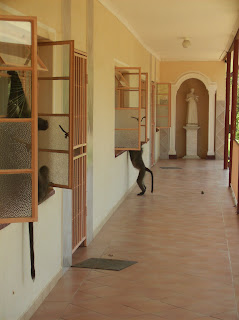






Christmas in South Africa 2009: Chacma baboons
I was thrilled with one of my Christmas highlights: spotting the Chacma baboons (Papio ursinus).
On first sighting, the baboons are thrilling to watch and you most certainly feel that you are in Africa when you see them. However, my hosts were less than thrilled with them because they are terribly destructive. If they come inside your house, and they are known to “break in,” they are more destructive than the worst of bandits.
They also have a terrible bite.
I was able to watch them nearly every day. They don’t pose well for the camera, but I got a few shots. (See more photos on my Facebook page):
http://www.facebook.com/album.php?aid=49447&id=1239371142&l=d58e8ed41a
The following excerpt on them is from Clive Walker’s, Signs of the Wild: A Field Guide to the Spoor and Signs of the Mammals of Southern Africa, 2000.
Diet: Omnivorous, fruits, leaves, tubers, roots, bulbs, scorpions—they are most adept at removing the sting from the tail, ground birds, eggs, insects, young mammals and most partial to crop raiding. The baboon will eat virtually anything.
General: A large, powerfully built primate with a prominent dog-like muzzle and a strong jaw with canines which exceed those of a lion in length. They are terrestrial, gregarious animals and are found in small and large troops. They possess considerable intelligence and have acute eyesight and hearing. Their enemies are the leopard and man. They will often be found in the company of antelope whose additional alertness supplements their own. They frequent several sleeping sites, occupying a large tree or ledges on mountain slopes. They are very noisy at dawn and dusk. Their voice is a loud, deep bark with a range of conversational utterings, shrieks and screams. Baboons have a high social structure and when danger threatens, the dominant males adopt a hostile stance to protect the agile and swift troop which rapidly disperses while the flanking members stand up in the grass or jump on to anthills or tree trunks to keep you in view whilst the troop disappears… (27).
Again, they were great fun to watch. And again, I don’t have to live with them! But it felt very “African” to see them out and about, and out of a cage!
Best, Karen
No comments:
Post a Comment